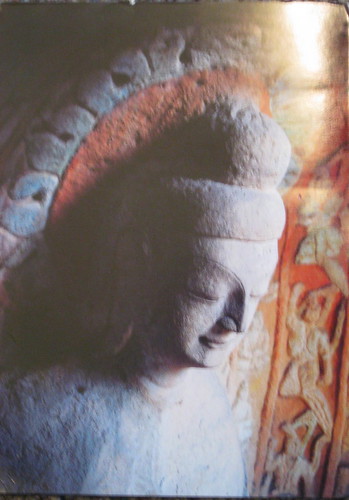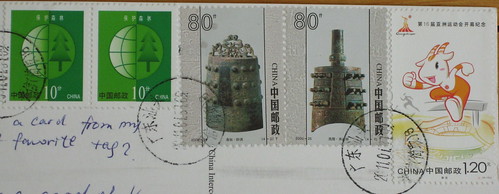
I got this card from one of the favorites tags. I chose it to post because I am currently reading the book Zen Baggage, by Bill Porter. The book is the story of his pilgrimage to the sites connected with the six patriarchs of Zen in China. One of the people in my zazen group recommended it. One of the sites the author visits is Yungang Grottoes, and this is the only place from the book (at least the part I've read so far) that I have a postcard from.
The Yungang Grottoes are a series of caves housing giant Buddha statues built by emperor Wen-ch'eng starting in the 5th century. His plan was to carve five caves, each representing one of the five kinds of knowledge (reality, perfect reflection, equanimity, subtle discrimination, and what works, according to Porter); because the imperial family paid for the project, each buddha was carved in the likeness of one of the family members. Sixty-four years later construction was complete - fifty thousand statues in more than fifty caves. The grottoes were listed as a UNESCO world heritage site in 2001.
These giant statues were about the same size as the presidents' heads on Mt. Rushmore. "Some of the buddha statues at Yunkang were so big the carvers had to use attendant bodhisattvas as pillars to hold up the buddhas' outstretched hands."
Porter goes on to say, "This was not art for art's sake, nor was it about the Buddhist goal of liberation from suffering. This was about inspiring awe and submission to authority... It was great art on a great scale, and I felt honored to have seen it. But I couldn't help wondering if such representations helped people on the road to liberation from the world of red dust or if they only furthered their enslavement to the objects of sensation. I could hear Subhuti answering the Buddha [in the Diamond Sutra], telling him that the Buddha could not be seen by means of the attributes he had acquired. And I could hear the Buddha adding, 'Since the acquisition of attributes is an illusion, Subhuti, the non-acquisition of attributes is not an illusion. Hence, by means of attributes that are not attributes the Buddha can, indeed, be seen.' All I saw were buddhas with attributes. The attributes that were not attributes would have to wait for another day."
Great stamps! The green ones on the left are from the set "protecting the common homeland of mankind," this one depicting forest conservation and issued in 2002. The two in the middle are "ancient bells from China" from 2000. The one on the left is Su Chime Bell from the spring and autumn period, and the one on the right is Jingshu Bell from the Western Zhou Dynasty. Finally, on the right is a more recent stamp, from 2010, celebrating the opening of the Guangzhou 2010 Asian Games. This one is "athletics." By the way, all this stamp info comes from this site.

No comments:
Post a Comment